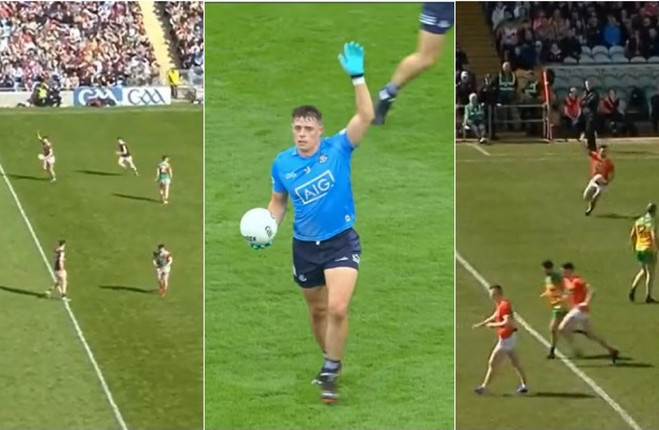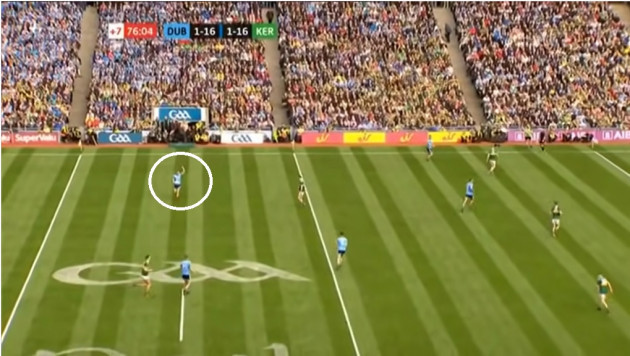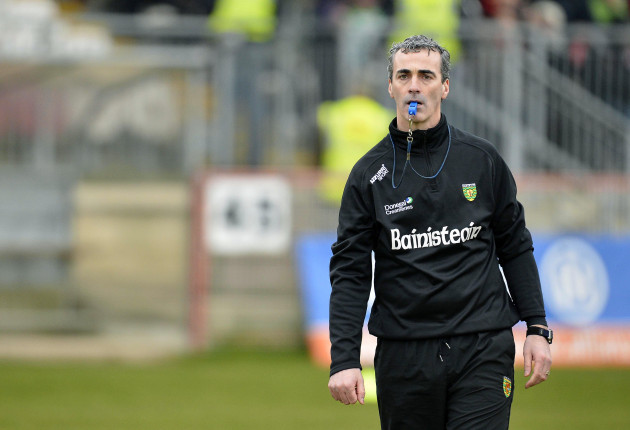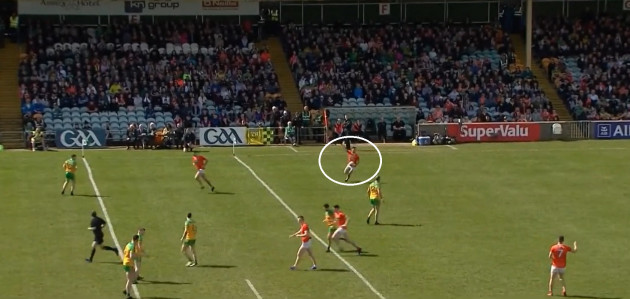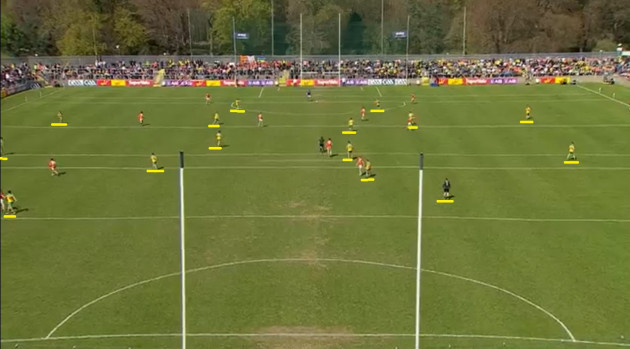‘I WONDER WHAT that signal from Aidan O’Shea was, to put his right arm in the air?’ asked RTE commentator Darragh Maloney during Mayo’s clash with Galway last Sunday.
‘Slow it down. Hold onto it. Recycle for a few seconds until something opens up,’ speculated Éamonn Fitzmaurice.
An informed guess. Like many of the current tactical trends, it was Dublin who started the ‘cool ball’ signal. First demonstrated by Paddy Small standing with his arm tall during the 2019 All-Ireland final draw against Fitzmaurice’s native county. At the time, the general coaching consensus was that after 90 seconds of continuous ball-in-play time, teams tire. Mistakes are common as lapses in concentration and conditioning take hold.
As Dublin encountered retreating opposition, they decided to manufacture those mistakes. Hold possession, stretch the play. Safe in the knowledge that their superior athleticism will allow them to persevere.
It was inevitable that others would try to replicate the trick.
“That is what coaching is,” says former Limerick footballer Stephen Lavin with a laugh. He runs the website ‘Game Sense Coaching’, a guide in teaching skills and tactical awareness.
“In the NFL, they call it the copycat league. The Patriots’ offence of 2007 was unreal. Three or four wide receivers, motion and everything. Loads of teams copied that. Or tried to anyway. Same thing with the West Coast offence.
“In football, Dublin were the pioneers for so much of what we see now. Everyone copied Donegal in 2012. Dublin set a new trend.
“I watch a lot of games from behind the goal and a lot of what teams do now stems from Dublin’s success. I think it really dawned when Tyrone came in 2018 and Dublin pulled that defence apart. It reinforced that teams need to come up with a new way of defending and they really honed in how Dublin were attacking.”
Follow the leader. At the turn of the century, Brian Dooher redefined the expectation of wing-forwards. Kieran Donaghy’s transfer to the edge of the square in 2006 inspired a raft of similar experiments. Club championships across the country are still spoiled by flimsy replicas of Jim McGuinness’s Donegal.
Naturally, duplications only start when some sort of success has been achieved. The sincerest form of flattery and all that jazz. It is one thing to hear the wheel has been invented. You’ll only really want one when you see someone storming past you.
If Mayo are copying Dublin’s signal, it is no surprise. They were the only county that came close to their level of conditioning. Extraordinary aerobic capacity was their emphasis. The priority.
After Dublin’s 2019 semi-final blitz, James Horan spoke at length about their superior engine while Mayo’s legs were ‘heavy’. Last year they performed sprints on the field post-championship victories. In the recent off-season, the county invited players to the Dome for a combine that included athletic testing.
Most notably, last year Mayo cracked the code. During the All-Ireland semi-final, Dublin led by five when Brian Howard raised his arm. That passage of play ended two minutes later with a free for Rob Hennelly to convert.
In the final ten minutes, Mayo outlasted Dublin and outscored them six points to one. Dublin mustered one single point in extra time. Last Sunday, Mayo outscored Galway 0-5 to no score in the final stretch. Any chance to delve into deeper reserves suits them.
Does it work for the rest? Results vary. When Gweedore attempted it against Kilcar in the 2020 club semi-final, the move broke down with some players on a different page. Corofin were more efficient with it against Kilcoo in that season’s All-Ireland club final. Armagh utilised it against Donegal last Sunday.
From the throw-in until the 3rd minute, Armagh did not touch the ball bar the goalkeeper kicking it out in Ballybofey. Eventually, they forced a turnover inside their own 21-metre line.
Donegal immediately withdrew to their own half and eventually Aidan Forker received possession on the halfway line. Then he held his hand aloft. 126 seconds and 25 passes later, Jarly Og Burns handpasses the ball over the bar for their first score.
Opposition coaches have noted Armagh’s use of signals and audible calls in recent seasons. One compares it to basketball and calling out the name of a play as teams progress up the court.
Jim Gavin constructed the most effective team to ever play the game. It is only natural the chasing pack would aspire to similar. But not everything is portable, it should be said. Lavin was involved with UL during their run to the Sigerson Cup final this year. They had one go-to kick-out routine. A safeguard in case they needed to break the opposition’s momentum. Anything more would be information overload given time and access constraints.
Coaching is about cutting your cloth according to your measure.
“Donie Buckley often says about kick-outs, everyone looks at Dublin and tries to do that. But what kick does your goalkeeper have? Your keeper should influence your kick-out strategy. Teams want a kick-out strategy like Cluxton or Beggan without having the ability to implement it.
“The first thing with coaching should be what kind of players you have. Teams are trying to implement what winning teams are doing.”
As well as that, what are the opposition’s strengths and weaknesses? Armagh thrive off early direct ball into their talented inside forward line and played with a rookie goalkeeper. So, Donegal withdrew numbers behind the ball to nullify the kick-pass but pressed the kick-out aggressively.
Kieran McGeeney’s outfit scored 0-9 from play, just 0-3 of which came from their own kick-out. Donegal scored 1-10 from play, 1-8 from their own kick-out and 0-3 off Rafferty’s restarts.
From kick-outs, Donegal pressed aggressively.
As soon as Armagh gained possession, players start to drop back.
How else have teams tried to mirror the six-in-a-row outfit?
“There are patterns of play and principles that everyone can incorporate. Slowing the game and dictating pace,” explains Lavin.
“Not giving up the centre when a team is coming through. Letting them build on the wings. Most teams now play with width. Every team tries to keep a forward up. Dublin started that.”
What is the next trend? Sometimes it is only subtle. Let’s take the recent winners. Tyrone’s set-up was more orthodox. They triumphed in the semi-final and final thanks to superior skill execution and decision-making. That should influence rather than inspire their rivals.
Lavin stresses external factors often dictate it. During his career, overcarrying was heavily policed. That is no longer the case, giving teams the opportunity to run the ball more.
Beyond that, it is anyone’s guess. He has some suggestions.
“I think football is a fascinating game now. It is so hard to say with certainty where it goes next. There are some things.
“You see this massive zonal press from kick-outs now. Will anyone try that in-game? A lot of teams hand-pass out of defence. Could we see a 14-man press? Dublin laid a small template when Cluxton came out and marked Tommy Walsh after they had a man sent off.
“I often wonder will a super organised team apply that press and then if it was beaten, know how to drop back. I think it will happen sometime but it takes time to embed. A version of a Gegenpressing.”
A bold and brave team will soon set the new template. Meanwhile, everyone else is wondering who will put their hand up next.
